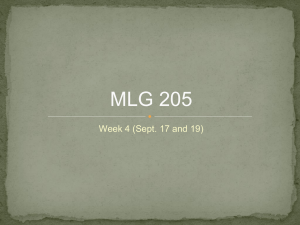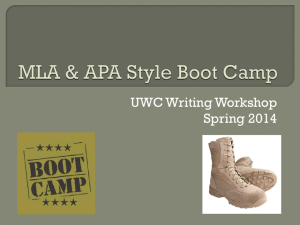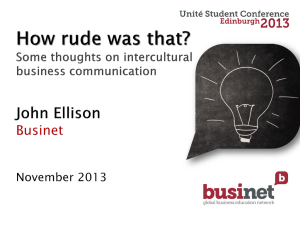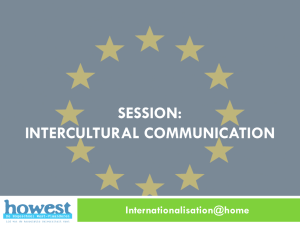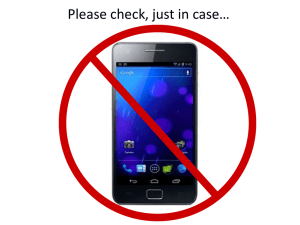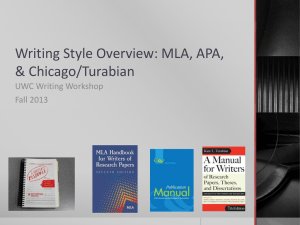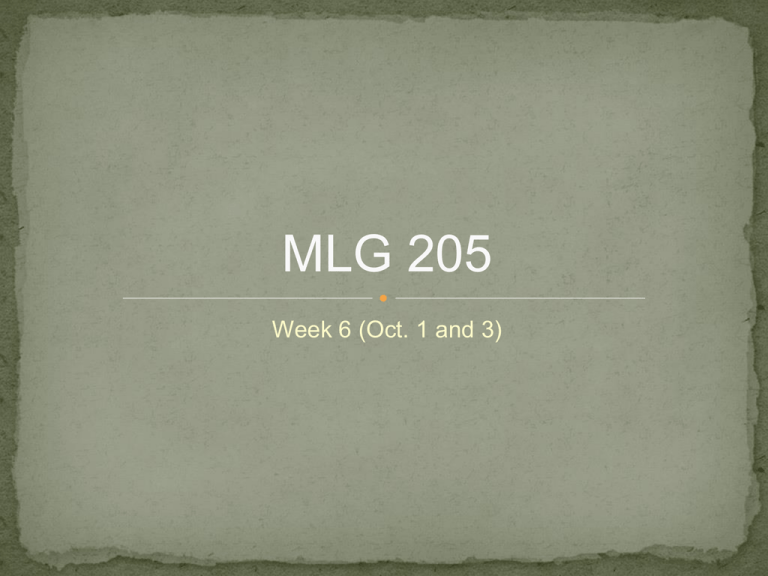
MLG 205
Week 6 (Oct. 1 and 3)
Agenda: Get ORGANIZED
●
●
●
●
Use your planner to write down your study plans for this week
Return APA Classwork
I will return Portfolios by Friday.
October 1
●
●
●
Introduce new study/good student skill
APA Workshop: Summarizing and Plagiarism / In-text Citations
Culture and Communication: Power
● October 3
●
●
APA Workshop: Summarizing and Plagiarism
Identity
● Assignments
●
●
●
October 8: Note-taking Journal 3 due
October 15: Listening and Speech Midterm
October 17: APA / Summarizing / Cross-Cultural Understanding
Midterm
● November 7: Portfolio Section 2 Due
Good Student Skill
Wayzgoose Press. (2013). Fifty ways to be a better student: Tips for college and
university students. Smashwords.com.
● Last Week:
● Know the Rules
● Did you try it? What happened?
● This Week:
● Have a Goal:
● “Have short-term and long-term goals” (regarding grades,
attendance, career, etc.)
● “Keep ‘service’ in mind”
Portfolio Section 2
● Goals Worksheet
● Textbook Review and Vocabulary Study
● Student Interview
● Professor Interview
Culture and Communication
Martin, J. N., & Nakayama, T. K. (2011). Experiencing intercultural
communication: An introduction (4th ed.). New York: McGraw Hill.
● What is “Power” in Communication?
“in every society, a social hierarchy exists that gives some
groups more power and privilege than others” (p. 52)
● Male vs. female / disabled vs. non-disabled / majority vs.
minority
● “Those in power, consciously or unconsciously, create
communication systems that reflect … their own ways of
thinking” (p. 52).
●
● Group-related Power
●
●
Involuntary groups: age, ethnicity, gender, physical ability, race
Voluntary groups: educational background, geographic location,
marital status, and socioeconomic status
Culture and Communication
Martin, J. N., & Nakayama, T. K. (2011). Experiencing intercultural
communication: An introduction (4th ed.). New York: McGraw Hill.
● Barriers to Intercultural Communication
Ethnocentrism: “the belief that one’s own cultural group (nationality)
is superior to all other cultural groups” (p. 54)
● “prevents people from even trying to see another’s point of view”
(p. 55)
● Stereotyping: Categorizing people
● “widely held beliefs about a groups of people”
● Can be positive:
● Attractive people are social
● Muslims are devoted
● Asians are smart
● Americans are free
● Can be negative:
● Muslims are sexist (ignore women) and violent
● Asians are poor
● Americans are rude
● Developed from our experiences and Media portrayal
●
Culture and Communication
Martin, J. N., & Nakayama, T. K. (2011). Experiencing intercultural
communication: An introduction (4th ed.). New York: McGraw Hill.
● Prejudice
● “a negative attitude toward a cultural group based on little or no
experience” (p. 57)
● Should we be “color-blind”?
● It’s not possible. We do notice color.
● Discourages meaningful conversations about race relations
● Allows people to continue to ignore the problem
● Discrimination
● “behavior that results from stereotyping or prejudice—overt
actions to exclude, avoid, or distance oneself from other groups”
(p. 60)
● Can be subtle: lack of eye contact, excluding someone from a
conversation
● Can be obvious: verbal insults, exclusions from jobs or
economic opportunities, physical violence, systematic
elimination of the group, genocide.
Culture and Communication
Martin, J. N., & Nakayama, T. K. (2011). Experiencing intercultural
communication: An introduction (4th ed.). New York: McGraw Hill.
● Activity
● Identify the various cultural groups you belong to, both
voluntary and involuntary. Choose two of these groups, and
think about each group and your membership in that group.
● Try to describe how belonging to that group influences your
perceptions. For example, how is your worldview influenced
by belonging to your family? By being a female or male?
By being an international student?
● Describe how your communication with others is influenced
by your membership in these two groups.
Homework
● Assignments
●
●
●
October 8: Note-taking Journal 3 due
October 15: Listening and Speech Midterm
October 17: APA / Summarizing / Cross-Cultural Understanding
Midterm
● November 7: Portfolio Section 2 Due
Agenda: Get ORGANIZED
●
●
●
●
Use your planner to write down your study plans for this week
Return APA Classwork
I will return Portfolios by Friday.
October 1
●
●
●
Introduce new study/good student skill
APA Workshop: Summarizing and Plagiarism / In-text Citations
Culture and Communication: Power
● October 3
●
●
Portfolio Section 2: Interacting with Professors/classmates
Identity
● Assignments
●
●
●
October 8: Note-taking Journal 3 due
October 15: Listening and Speech Midterm
October 17: APA / Summarizing / Cross-Cultural Understanding
Midterm
● November 7: Portfolio Section 2 Due
Identity and Intercultural
Communication
Martin, J. N., & Nakayama, T. K. (2011). Experiencing intercultural
communication: An introduction (4th ed.). New York: McGraw Hill.
● What is “Identity”?
●
●
“created by the development of the ‘self’ (our self concept)” (p.
92)
How are identities created?
●
●
●
●
●
●
Identities are Created through Communication: “Does everyone
see you as you see yourself?”
Identities are created in spurts:
● Events that provide insight
● Framed by long periods
Identities are Multiple: Belong to various groups / various
contexts that highlight our identities
Identities are influenced by society: It is very difficult to change
involuntary identities because they are chosen before we are
born.
Identities are Dynamic: For example, Women today vs. Women
100 years ago.
Identities are developed in different ways in different Cultures.
Identity and Intercultural
Communication
Martin, J. N., & Nakayama, T. K. (2011). Experiencing intercultural
communication: An introduction (4th ed.). New York: McGraw Hill.
● Social and Cultural Identities:
● Gender Identity
●
●
●
●
Biological Sex is not the same as gender identity:
Communicated through activities and appearance – What does it
mean to be a man or woman?
Sexual Identity
Age Identity
Racial and Ethnic Identity
●
●
Racial Identity = biological or cultural?
Ethnic Identity = involves a common sense of origin and history
that link us to distant cultures (Mexican-American, JapaneseAmerican)
Identity and Intercultural
Communication
Martin, J. N., & Nakayama, T. K. (2011). Experiencing
intercultural communication: An introduction (4th ed.). New
York: McGraw Hill.
●
●
●
●
Physical Ability Identity: Height, weight, sex, age
Religious Identity
Class Identity
National Identity: Legal status in relation to a nation. Often
perceived based on the world stage.
● Regional Identity
● Personal Identity:
● How we behave and communicate to others helps construct
our personal identity.
● Sometimes it is largely defined by outside forces
● If you think you are incredibly attractive, but others do not,
are you attractive?
Portfolio Section 2
● Goals Worksheet
● Textbook Review and Vocabulary Study
● Student Interview
● Professor Interview
APA Workshop: In-text Citations
● Review: Return Classwork
● Summarizing
● What is it?
● How do you do it?
● https://owl.english.purdue.edu/owl/resource/563/01/
Overall, the first two quarters of 2008 have been
profitable to the company. Nineteen of twenty
departments report cutting costs at least twenty percent,
and sales from fifteen departments have risen five
percent, or about $5 million. Despite these positive
developments, most department heads believe that they
will not be able to maintain these levels for the remainder
of the year.
Summary: The company has driven profits from
January to June of 2008, but the rest of the year is
not expected to be as good.
● Original:
●
APA Workshop: In-text Citations
● In-text Citations
● Use quotations, paraphrases, summaries in your
research
● Practice:
https://owl.english.purdue.edu/owl/resource/560/05/
● Practice: Use your textbook; choose one paragraph
● Write one quotation
● Write a paraphrase of the quotation
● Write a summary of the paragraph
● Use in-text citations
● How to do it Microsoft Word
● Plagiarism

